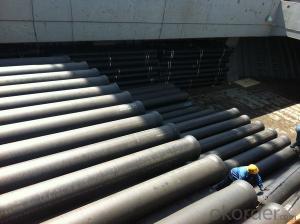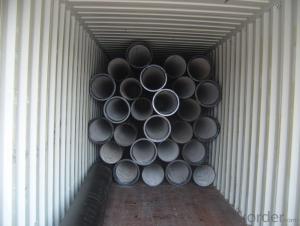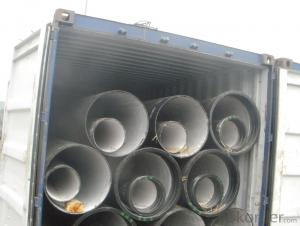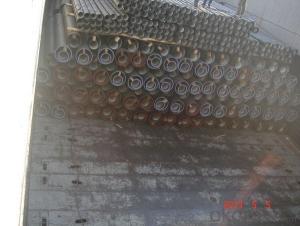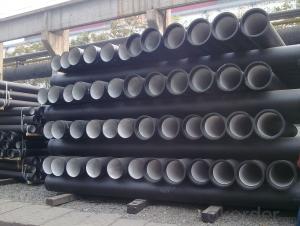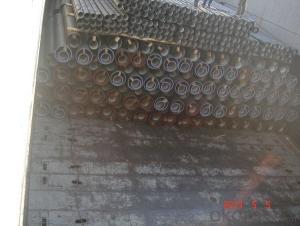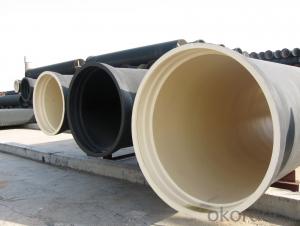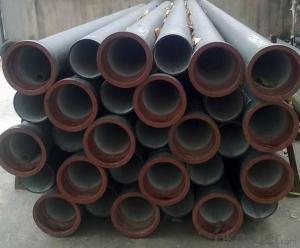DUCTILE IRON PIPES&PIPE FITTINGS C CLASS DN100
- Loading Port:
- Tianjin
- Payment Terms:
- TT OR LC
- Min Order Qty:
- 25 m.t
- Supply Capability:
- 30000 m.t/month
OKorder Service Pledge
OKorder Financial Service
You Might Also Like
Material : Ductile Cast Iron
Size Range : DN 80mm to DN 2000mm
Unit Effective Length : 6m or 5.7m
Manufacture Standard: ISO 2531:1998/ EN 545:2006/EN 598:2007
Annual capacity : 200,000 tons
Coating Exterior: Zinc 130g/m2 according to ISO 8179-1 and bitumen coating 70 microns.
Cement Interior: Portland Cement/ High Alumina Cement/ Sulphate Resisting Cement Lining according to ISO 4179
Special requirements on external coating and internal lining can be applied
We also provide accessories such as SBR/EPDM rubber gaskets, lubricant paste, pipe caps, PE sleeves, etc.
Additional Parts:
Each pipe is strictly inspected according to related standard to ensure permanently high performance.
Easy Installation at site and service free for life
Long Service Lifespan
Quotation will arrive you within 24hours once we get your inquiry.
We guarantee offering you a competitive price.
A copy of original inspection reports of pipes will be offered after shipment.
Photos of loading process will be sent to the customer after shipment effect.
We will follow-up the delivery progress after shipment effect and update to the customer on weekly basis.
- Q: What is the maximum operating pressure for ductile iron pipes?
- The maximum operating pressure of ductile iron pipes may vary based on factors like pipe diameter, wall thickness, and the specific usage. Nonetheless, typically, ductile iron pipes are engineered to endure pressures of up to 350 psi (pounds per square inch), and occasionally even higher. It is worth highlighting that to ascertain the precise maximum operating pressure for a specific ductile iron pipe system, one should refer to local regulations, engineering standards, and manufacturer specifications.
- Q: Are ductile iron pipes suitable for high-temperature applications?
- Ductile iron pipes are generally not suitable for high-temperature applications. While ductile iron is known for its strength and durability, it has limitations when it comes to high temperatures. Ductile iron pipes are typically rated for a maximum operating temperature of around 250-300 degrees Fahrenheit (120-150 degrees Celsius). At higher temperatures, ductile iron pipes can experience thermal expansion, which may lead to cracking or distortion. This can compromise the structural integrity of the pipe and potentially cause leaks or failures. Additionally, ductile iron is susceptible to oxidation at elevated temperatures, which can further degrade the pipe's performance over time. For high-temperature applications, it is generally recommended to use materials specifically designed for such conditions, such as stainless steel or high-temperature alloys. These materials offer better resistance to thermal expansion, oxidation, and other factors associated with high temperatures.
- Q: Can ductile iron pipes be used for bridge drainage systems?
- Yes, ductile iron pipes can be used for bridge drainage systems. Ductile iron is a strong and durable material that is commonly used in various applications, including water and sewage systems. It has excellent corrosion resistance and can withstand heavy loads and pressure, making it ideal for bridge drainage systems. Additionally, ductile iron pipes have a smooth inner surface that allows for efficient water flow, preventing clogs and blockages. Therefore, ductile iron pipes are a suitable choice for bridge drainage systems due to their strength, durability, and ability to handle the required water flow.
- Q: How do ductile iron pipes perform in high-altitude areas?
- Ductile iron pipes perform well in high-altitude areas due to their inherent strength and durability. The properties of ductile iron, including its high tensile strength and impact resistance, make it suitable for withstanding the challenges posed by high-altitude environments. One of the key advantages of ductile iron pipes is their ability to resist internal and external pressures. In high-altitude areas, where water pressure may vary significantly, ductile iron pipes can withstand the changes without compromising their structural integrity. This ensures the reliable and continuous flow of water without the risk of pipe failures or leaks. Ductile iron pipes also exhibit excellent resistance to corrosion, which is crucial in high-altitude areas where the atmospheric conditions can be more harsh and unpredictable. The pipes' protective lining and external coatings provide an additional layer of defense against corrosion, ensuring their longevity and reducing the need for frequent maintenance or replacements. Moreover, ductile iron pipes have a higher tolerance to temperature variations compared to other materials. In high-altitude areas, where temperature fluctuations can be extreme, these pipes can withstand the expansion and contraction without cracking or rupturing. This thermal stability is essential for maintaining the structural integrity of the pipeline system and preventing costly repairs. In summary, ductile iron pipes are well-suited for high-altitude areas due to their strength, durability, resistance to pressure variations, corrosion resistance, and thermal stability. These properties make them a reliable choice for water distribution systems in such environments, ensuring the continuous supply of water without compromising safety or efficiency.
- Q: What are the different types of joints used in ductile iron pipes?
- Ductile iron pipes commonly utilize various types of joints to achieve secure and leak-proof connections between pipe sections. Here are some of the frequently employed joint types: 1. Push-on joint: This joint type offers easy installation without the need for specialized tools. It entails lubricating the gasket on one pipe end and inserting it into the socket of the adjacent pipe. The gasket ensures a tight seal to prevent any leakage. 2. Mechanical joint: Consisting of a gland and a follower gasket, this joint type involves placing the gland over the spigot end of one pipe and inserting the follower gasket into the bell end of the neighboring pipe. Bolts and nuts are then used to tighten the gland, compressing the gasket and creating a secure joint. 3. Restrained joint: In applications requiring restraint against axial movement or pressure thrust, this joint type is utilized. Typically, it involves a mechanical joint combined with additional components like tie rods, thrust blocks, or restrained couplings to provide the necessary restraint. 4. Flanged joint: Large diameter ductile iron pipes often employ flanged joints. They consist of a flange on one pipe end and a mating flange on the other pipe end. The two flanges are bolted together, establishing a robust and secure connection. Flanged joints enable easy disassembly and reassembly when necessary. 5. Welded joint: Welded joints are created by fusing the ends of two pipes together using heat and pressure. This type of joint ensures a permanent and strong connection. Welded joints are commonly employed in underground or buried applications where long-term durability is a crucial factor. It is essential to consider factors such as pipe diameter, application, and project requirements when selecting the appropriate joint type. Consulting with a professional engineer or referring to the manufacturer's guidelines is recommended to ensure the suitable joint type is chosen for ductile iron pipes.
- Q: Can ductile iron pipes be made of flexible waterproof sleeves?
- Usually, a bushing is used to make a pool. It is the conduit to the sink. However, the common casing is difficult to seal so that there is water leakage between the casing and the pipe and water leakage between the casing and the wall. Only the waterproof sleeve can solve the water leakage between the casing and the wall, but it can not solve the seal between the casing and the pipe, and the flexible waterproof bushing can solve two problems.
- Q: Can ductile iron pipes be used for cooling water systems?
- Yes, ductile iron pipes can be used for cooling water systems. Ductile iron pipes have excellent corrosion resistance and high-pressure capacity, making them suitable for conveying cooling water. Additionally, their strength and durability ensure long-term performance and stability in cooling water applications.
- Q: Is there any cast iron pipe used in the fire hose?
- I do not know, are generally seamless steel pipe or spiral pipe, straight seam pipe.
- Q: Can ductile iron pipes be used for gravity sewer systems?
- Yes, ductile iron pipes can be used for gravity sewer systems. Ductile iron pipes are known for their durability, strength, and resistance to corrosion, making them suitable for various applications including sewer systems. These pipes have excellent tensile strength and can withstand high pressure and heavy loads, making them ideal for gravity sewer systems where wastewater flows by gravity rather than being pumped. Additionally, ductile iron pipes have a long lifespan and require minimal maintenance, making them a cost-effective choice for sewer infrastructure.
- Q: How much pressure can the ductile iron pipe socket meet?
- If it is a general installation, you can rest assured, are within the scope of tolerance.
Send your message to us
DUCTILE IRON PIPES&PIPE FITTINGS C CLASS DN100
- Loading Port:
- Tianjin
- Payment Terms:
- TT OR LC
- Min Order Qty:
- 25 m.t
- Supply Capability:
- 30000 m.t/month
OKorder Service Pledge
OKorder Financial Service
Similar products
Hot products
Hot Searches
Related keywords











